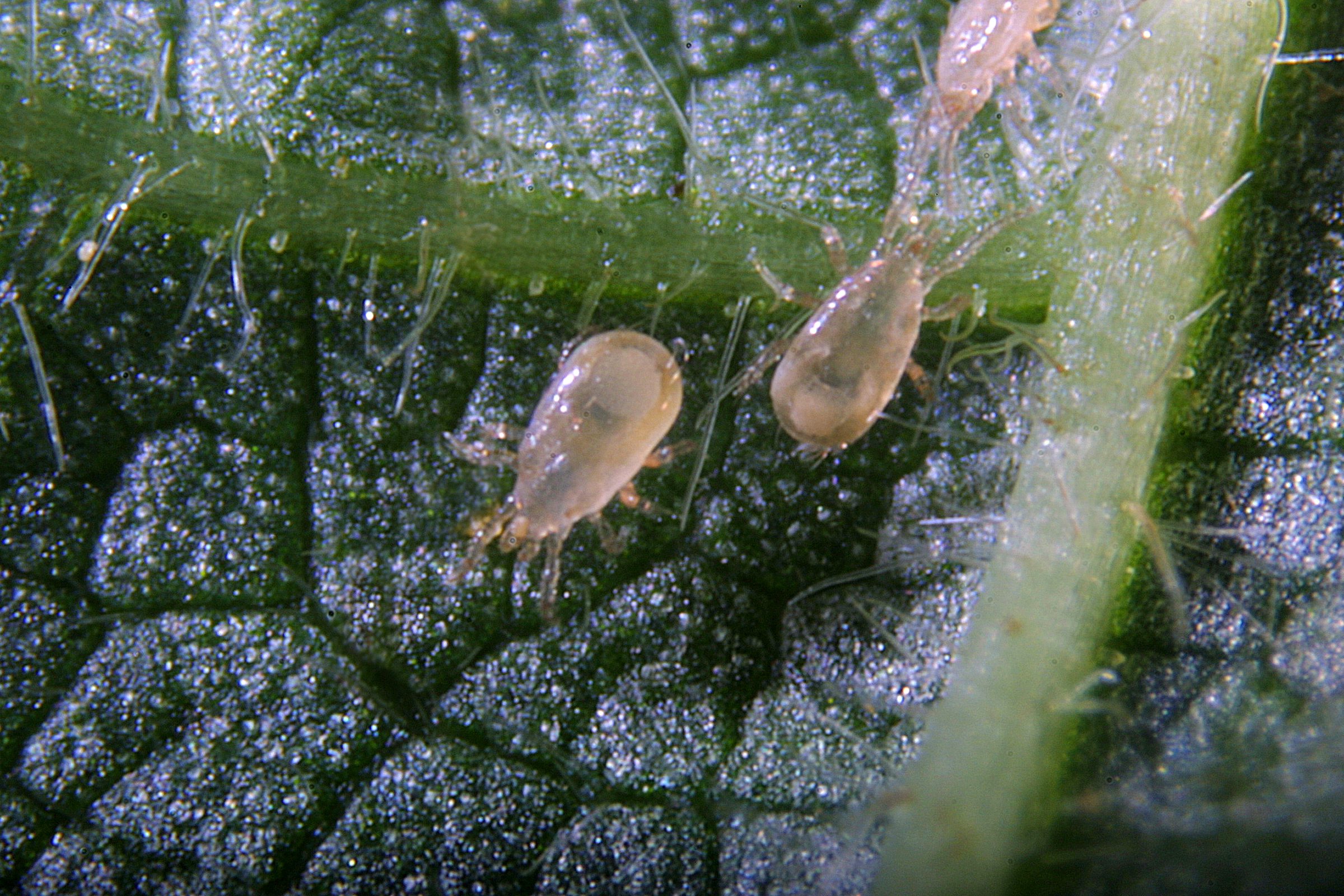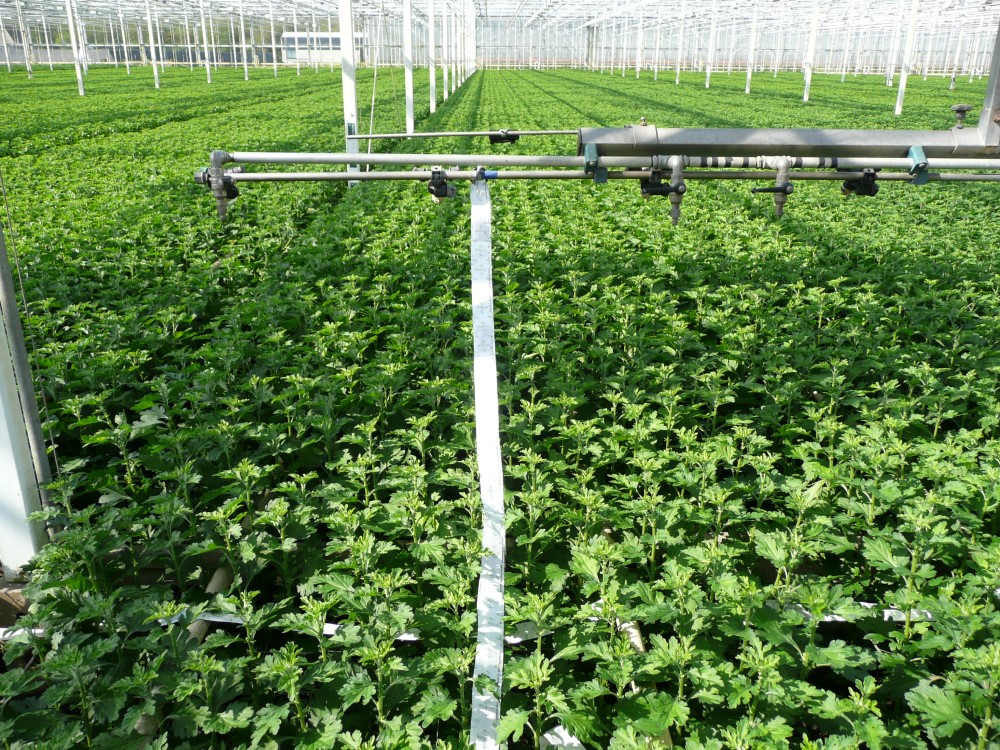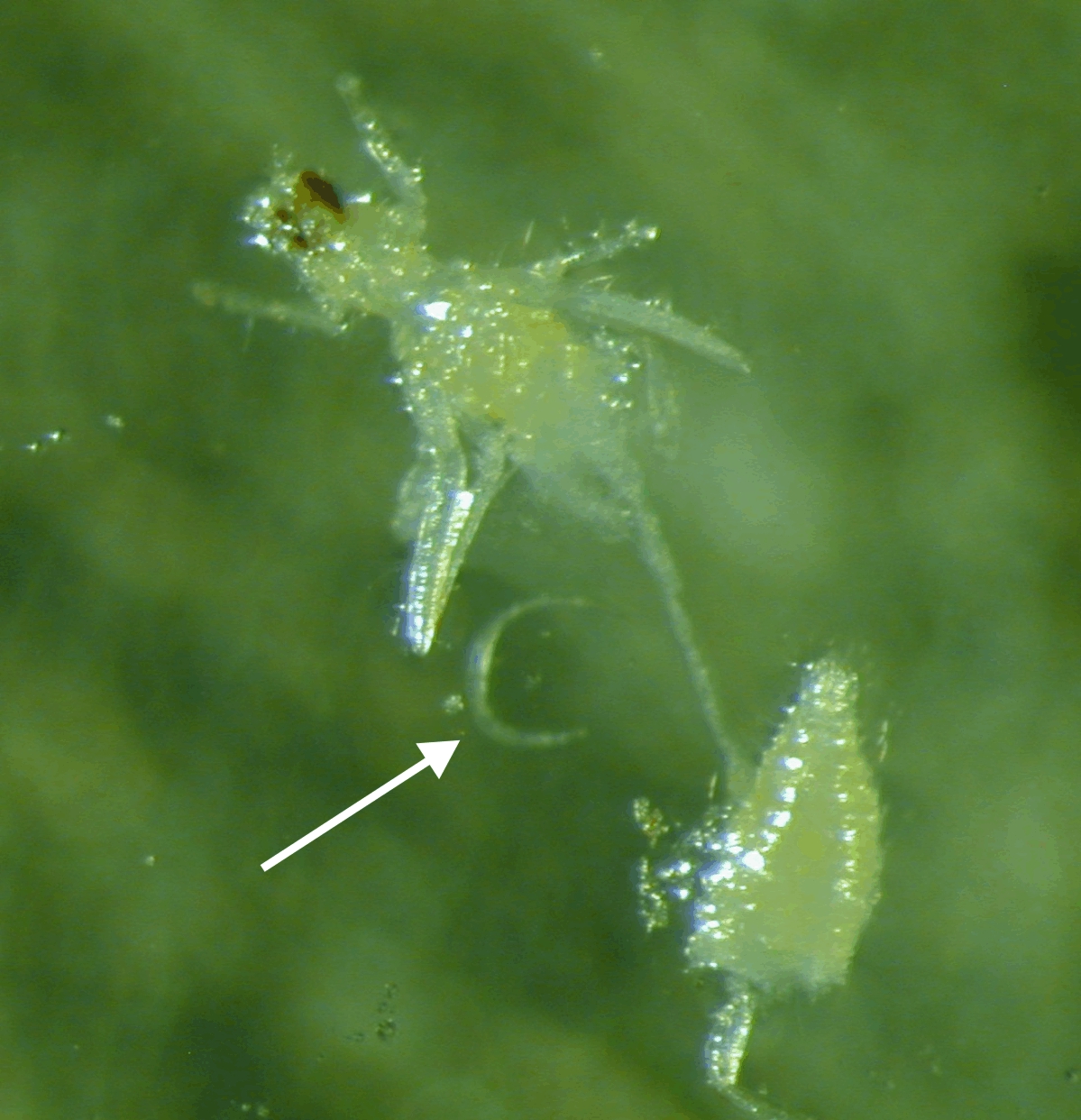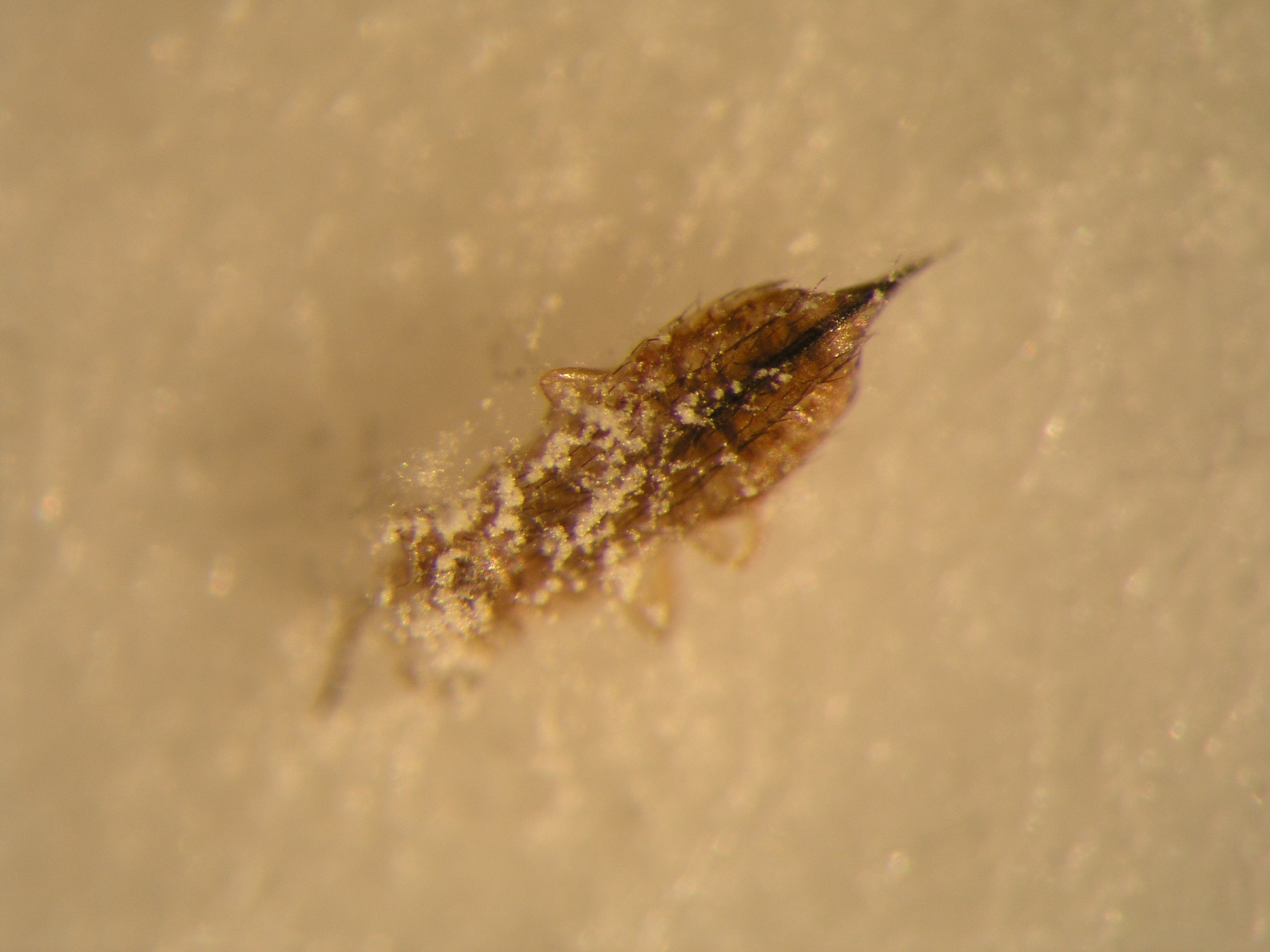Please click here to access the main AHDB website and other sectors.
- Home
- Knowledge library
- IPM strategies to control thrips in protected ornamental crops
IPM strategies to control thrips in protected ornamental crops
Management of thrips on protected ornamentals is best achieved using an integrated control strategy involving a combination of cultural, biological and chemical control methods.
Back to: Thrips control in protected ornamental crops
Cultural control of thrips in protected ornamentals
Prevention of any thrips problems is better than cure and cultural control methods play an important part in thrips management:
- Minimise thrips carry-over from infested crops to following crops by maintaining good nursery hygiene:
- Promptly and carefully dispose of any crop debris, unmarketable plants, weeds, used pots, trays and old matting. Place into sealed bags or covered containers, sited as far away from the glasshouses/polythene tunnels as possible, before disposal
- Sweep, pressure wash and disinfect benches and concrete floors between crops
- Ideally use new pots, trays and matting for each crop, or sterilise any to be re-used
- Steam disinfestation of soil between cut flower crops may be an option to reduce the risk of survival of thrips pupae
- Sticky traps or roller traps can be used to trap thrips adults in empty structures or between infested crops and new batches of plants. They should be positioned and timed with care to avoid catching too many flying biological control agents
- Maintain strict weed control inside and immediately around glasshouses and tunnels, including any empty structures
- Do not take cuttings from infested mother plants
- Remove any heavily infested plants and any showing virus symptoms
- Staff should work in ‘clean’ structures before entering known infested areas in any one day, as thrips can be carried on clothing
Biological control of thrips in protected ornamentals
Many biological control agents are available for the control of thrips. Those used on protected ornamentals are summarised below. Choice, combinations, timings and rates of release or application within an integrated pest management (IPM) programme should be planned carefully. If necessary, seek advice from the supplier or specialist IPM consultant.
Predatory mites
Several species of predatory mite are available for control of thrips. Choice will depend on temperatures in the structure, thrips species and life stages being targeted, and whether control of whiteflies is also needed. Application methods can vary according to crop.
Neoseiulus cucumeris
This native predatory mite is the main biological control agent used against thrips in the UK and can give very good control of western flower thrips (WFT) on bedding, pot plants and cut flower crops. However, N. cucumeris does not control Japanese flower thrips on UK ornamental or herb crops, possibly because the first instar larvae are larger than those of WFT. Therefore, alternative predatory mite species are needed for control of this thrips pest (see the following section).
N. cucumeris feeds only on first instar WFT thrips larvae, so successful control of WFT depends on a regular preventive release programme. The predator can develop from between around 8°C and 30°C but ideally needs a few hours of 15–25°C each day for best effect and needs relative humidities of 65–75% in the plant microclimate for the eggs to survive. Adult mites are oval, beige and about 0.4 mm long. They are wingless, so are best applied to touching plants to allow them to walk from plant to plant. They can be difficult to find on ornamental plants as they are usually in the same hiding places as the thrips larvae on which they feed.
Neoseiulus cucumeris predatory mites

Image © Bioline AgroSciences.
N. cucumeris can be sprinkled onto plants each week in a bran or vermiculite carrier, either by hand or using an automatic applicator such as the Koppert ‘Airobug’ which saves on labour time and gives a more even distribution. Alternatively, the predators can be released every six to eight weeks using controlled release paper sachets that are hung onto plants, pots or baskets. As an alternative to individual sachets, ‘Bugline’ strips of sachets are available from Bioline AgroSciences for use in cut flowers that can be applied using the sprayer gantry to pull them out over the crop.
Predatory mites and other biological controls can be quickly and evenly distributed using the Koppert ‘Airobug’

Image © Koppert Biological Systems.
Predatory mites for thrips control can be released to cut flower crops using the Bioline AgroSciences ‘Bugline’ strips

Image © Marilyn Steiner.
Transeius montdorensis, Amblyseius swirskii and Amblydromalus (Typhlodromalus) limonicus
These predatory mite species are very similar in appearance to N. cucumeris but they can be more effective predators as they feed on both first and second instar thrips larvae (including those of Japanese flower thrips and poinsettia thrips) as well as on whitefly eggs and young scales. During early 2021, UK growers of both protected ornamentals and herbs infested with Japanese flower thrips switched from using N. cucumeris to using Transeius montdorensis and results to date have been promising.
All three mite species are alien to the UK, so unlike N. cucumeris which is native and can be released in glasshouses, tunnels and outdoors, these three species need licences for release in different countries within the UK. All three species can be released in fully enclosed glasshouses throughout the UK, but not all are licensed for release in tunnels, so check with your supplier regarding local release restrictions.
T. montdorensis will develop from 12°C, although optimum temperatures are above 20°C, and it can still be effective up to around 33°C. This species seems to establish better on Chrysanthemum than other species. Amblyseius swirskii is best used at temperatures of 20–33°C, whereas Amblydromalus limonicus is best used in cooler temperatures of 13–25°C. Release methods for all three species are similar to those for N. cucumeris.
Stratiolaelaps scimitus (Hypoaspis miles) and Macrocheles robustulus
These ground-dwelling predatory mites are primarily used for the control of sciarid flies. However, they will also feed on other prey in the growing media, soil or on floor or bench coverings, including thrips pupae. They should not be relied upon as the sole method of thrips control, but can supplement control when used in combination with other biological agents such as other predatory mite species used against larvae on the plants.
Adult females of both species are up to 0.8 mm long, off-white with a pale brown shield covering most of the upper surface of the body. The predators need moist growing media, soil or substrate and temperatures above 15°C. They are supplied in tubs with a peat and vermiculite carrier for sprinkling onto pots, trays, benches or floors. They are very active and can be seen running on the substrate surface or under pots and trays.
Supplementary food for boosting numbers of predatory mites applied to foliage
Several products are available from biological control companies for boosting numbers of predatory mites. Cattail (Typha) pollen is available as ‘Nutrimite’ from Biobest, which has been shown to boost numbers of some species of predatory mites, including A. swirskii and T. montdorensis. Two ‘feeder mite’ products are available, containing prey mites as supplementary food for some species of predatory mites, including all those supplied for thrips control.
‘Nutari’ is available from Koppert and contains Carpoglyphus lacti and ‘Mitefood’ is available from Bioline Agrosciences and contains Thyreophagus entomophagus. So far these products have not been used to any great extent in UK ornamental crops.
Other biological control agents
As well as predatory mites, a range of other biological control agents are also available that give control of thrips, these are summarised below.
Dalotia (Atheta) coriaria
This ground-dwelling predatory rove beetle is available for control of sciarid and shore flies. Both the adults and larvae will also eat other prey in the growing media or soil, including thrips larvae and pupae.
The adult beetle is 3–4 mm long, dark brown and shiny, with short wings and an upturned rear end. The adults are very active and can both run and fly, but often remain hidden within the growing media and under pots or trays. The young larvae are small and white and the older larvae are 3–4 mm long and brownish-yellow.
Research in AHDB project PC 261 showed that the predators reduced WFT numbers on Impatiens as a result of using the grower ‘DIY’ rearing-release system developed in AHDB project 239a.
Orius laevigatus
This predatory bug is native to the UK and is widely used in protected sweet pepper and strawberry crops for WFT control and some growers of ornamentals have used it to supplement control with predatory mites. The predator feeds on both thrips adults and larvae and unlike predatory mites the adult bugs can fly to find prey. In flowering crops with suitable pollen, Orius laevigatus can establish before thrips infestation by feeding on pollen. O. laevigatus needs at least 15°C for egg laying to occur and at least 20°C and plenty of prey or suitable pollen for good establishment.
Lacewings
The green lacewing, Chrysoperla carnea is native to the UK and is available as eggs or larvae for the control of aphids, but the larvae will feed on other prey including both WFT adults and larvae. Research in the Netherlands has also shown that releases of high numbers of larvae reduced numbers of T. setosus on Hydrangea. The adults are not predatory and the predator will not establish in glasshouses, therefore repeated releases of larvae are needed.
Steinernema feltiae
These entomopathogenic nematodes were first developed as growing media drenches for the control of sciarid fly larvae. However, they are now also used successfully as foliar applications for WFT control, particularly on Chrysanthemum. The nematodes kill the thrips by releasing bacteria from their gut once inside the host insect’s body. Steinernema feltiae can kill WFT adults and larvae on the plants, but their main role in WFT control is by killing thrips larvae that drop to the ground to pupate, and the pupal stages in the ground.
WFT prepupa infected with Steinernema feltiae. Arrow points to nematode infective juvenile released from the body of the dead thrips

Image © ADAS Horticulture.
Nematode applications should be made weekly, and as they do not give a quick knock-down of thrips, they should be used preventively or started at low WFT densities. The microscopic nematodes are supplied in a gel-like carrier in plastic trays, for application in water as foliar sprays. It is critical to follow all the product recommendations for effective results, such as application rate and use-by date, removal of fine filters in the spray lines and continued agitation of the spray tank during application.
Entomopathogenic fungi
Entomopathogenic fungi are microbiological bioprotectants and threfore need to be approved for use in the UK (unlike predators, parasitoids and nematode biological control agents). Two species of fungi products are approved for use on protected ornamentals in the UK that will give some control of thrips.
Lecanicillium muscarium (Mycotal)
Mycotal is recommended for control of whitefly, but will also infect thrips. It is approved for use on ornamentals under permanent protection and is supplied as spores in water dispersable granules for application in water as a high volume spray together with the adjuvant Addit. For the best effect, applications should start when pest numbers are low and when temperatures are 18–30°C and relative humidity is at least 70%. It is therefore most suitable for use during warm, humid weather, in propagation houses, or when rooting cuttings. Once the fungus has germinated and colonised the thrips body, it can be seen as white fluff on the body surface. Fungicides need to be chosen with care and their application timed to cause least harm to Mycotal; check the product label.
Beauveria bassiana (Botanigard WP and Naturalis-L)
Like Mycotal, both these products are recommended for control of whitefly, but will also infect thrips. Both products are approved for use on ornamentals under permanent protection for application as foliar sprays. Both products need temperatures of 20–30°C and a relative humidity above 60% (Naturalis-L) and 70% (Botanigard WP). Both products work in a similar way to Mycotal. Infected thrips are covered with small round balls of white fungus. As with Mycotal, fungicides need to be chosen with care to avoid harm to the active ingredient both products; check the product labels and contact the suppliers if in doubt.
Thrips infected with Beauveria bassiana, covered with small balls of white fungus
Image © Warwick University.
Chemical control of thrips in protected ornamentals
Thrips are generally difficult to control with plant protection products alone. For example, western flower thrips are resistant to many insecticides and UK populations of onion thrips can also be resistant to pyrethroids. Thrips are also difficult targets for contact-acting products, as adults and larvae are often located on leaf undersides or in buds, growing points or flowers, and most pupae are in the growing media or substrate.
Various sugar products (Adpro Attrack, Biosweet and Combi-protec) are available as adjuvants that claim to improve control when using plant protection products, either by luring thrips out of sheltered places to increase exposure during spraying, or by increasing efficacy of ingested actives.
A plant protection product should only be used if necessary. The choice will depend on the thrips species present, history of efficacy on the nursery and whether or not biological control agents are being used to control either thrips or other pests. Applications should be planned according to product label recommendations; permitted frequency and number of applications and resistance management guidelines. If using biological control agents in an integrated pest management (IPM) programme, products should be selected and applications timed carefully, using the least harmful and persistent products where possible.
Table 1 lists bioprotectant, physically acting and conventional plant protection products that are currently approved on protected ornamentals and may give some control of thrips.
Table 1. Currently approved plant protection products on protected ornamentals that may give some control of thrips
|
Example product(s) |
Active ingredient |
Chemical group (IRAC group) |
Approval status for protected ornamentals |
IPM compatibility* |
Comments |
|
Bioprotectants
|
|||||
|
Azatin |
Azadirachtin |
Azadirachtin (botanical bioprotectant) |
On-label approval (permanent protection). Recommended for thrips control |
Safe/slightly harmful |
Partially systemic on some host plants |
|
Botanigard WP Naturalis-L |
Beauveria bassiana
|
Entomopathogenic fungus (microbial bioprotectant) |
Botanigard WP – on-label approval (permanent protection). Recommended for whitefly control
Naturalis-L – on-label approval (permanent protection). Recommended for whitefly and reduction of thrips |
Safe to most biological control agents |
Botanigard WP – contact action
Needs 20–30°C and over 70% relative humidity for optimum control
Naturalis-L – contact action
Needs 20–30°C and over 60% relative humidity for optimum control |
|
Eradicoat Eradicoat Max Majestik |
Maltodextrin |
Botanical bioprotectant |
On-label approval for all non-edible crops (permanent protection for Eradicoat Max). Recommended for spider mite and whitefly control |
Safe to biological control agents once spray deposit is dry |
Contact action |
|
Flipper |
Fatty acids |
Botanical bioprotectant |
EAMU 1415/2020 – control of aphids, spider mites, whitefly |
Safe/moderately harmful to biological control agents depending on species. Safe once spray deposits dry |
Contact action
Use soft or rain water or add X-Fusion conditioner |
|
Mycotal |
Lecanicillium muscarium
|
Entomopathogenic fungus (microbial bioprotectant) |
On-label approval (permanent protection). Recommended for whitefly control |
Safe to most biological control agents |
Contact action
Use with Addit
Needs at least 18°C and 70% relative humidity for optimum control |
|
Physically acting products (exempt from plant protection product regulations)
|
|||||
|
ProTAC SF |
Silicone polymers, siloxanes and organic antioxidants |
Physically acting |
Exempt |
Likely to be harmful to biological control agents hit by the spray, but safe once spray residues dry |
Contact action
Spray during day in low humidities to avoid plant scorch
Do not spray to flowering crops due to high risk of damage |
|
Chemical plant protection products
|
|||||
|
Batavia
|
Spirotetramat |
Ketoenol (Group 23) |
EAMU 2597/2019 – permanent protection, for control of western flower thrips (WFT), aphids and whitefly |
Harmful to Phytoseiulus persimilis for 3–4 weeks
Moderately harmful to Transeius montdorensis
Safe/slightly harmful to most other biological control agents |
Two-way systemic action
Do not spray specified ornamentals including Begonia, Cyclamen and Hydrangea due to high risk of damage |
|
Clayton Abba Dynamec
|
Abamectin |
Avermectin (Group 6) |
On-label approval (permanent protection). Recommended for WFT control |
Harmful to nematodes for up to 7 days and to most other biological control agents for 1–3 weeks depending on species (6 weeks for Orius species) |
Contact and translaminar action |
|
Clayton Cajole Sumi-Alpha
|
Esfenvalerate |
Pyrethroid (Group 3) |
On-label approval
Recommended for control of thrips and other pests on flowers |
Safe to nematodes. Harmful to most other biological control agents for up to 12 weeks |
Contact action
WFT and onion thrips likely to be resistant |
|
Clayton Vault Gazelle SG
|
Acetamiprid |
Neonicotinoid (Group 4A) |
On-label approval
Recommended for aphid and whitefly control |
Harmful to most biological control agents for 1–3 weeks depending on species (6 weeks for Orius species) |
Systemic action |
|
Conserve
|
Spinosad |
Spinosyn (Group 5) |
On-label approval
Recommended for WFT control |
Harmful to some biological control agents for up to 2 weeks |
Contact and ingestion action
WFT and onion thrips likely to be resistant |
|
Decis Forte
|
Deltamethrin |
Pyrethroid (Group 3) |
On-label approval. Recommended for control of various pests |
Safe to nematodes. Harmful to most other biological control agents for up to 12 weeks |
Contact action
WFT and onion thrips likely to be resistant |
|
Hallmark with Zeon Technology |
Lambda-cyhalothrin |
Pyrethroid (Group 3) |
EAMU 2944/2008 |
Safe to nematodes. Harmful to most other biological control agents for up to 12 weeks |
Contact action
WFT and onion thrips likely to be resistant |
|
Spruzit
|
Pyrethrins |
Pyrethrins (Group 3)
|
On-label (permanent protection). Recommended for thrips (not WFT) and other pests |
Harmful to some biological control agents for up to 1 week |
Contact action
WFT and onion thrips likely to be resistant |
- The information in this table has been collated using information from the Health and Safety Executive (HSE) website (gov.uk) and from suppliers’ labels and product technical information. Important – regular changes occur in the approval status of plant protection products, arising from changes in the legislation or for other reasons. For the most up to date information, please check the HSE website or with a professional supplier or BASIS-qualified consultant, as information could have changed since this factsheet was produced
- EAMU – Extension of Authorisation for minor use
- Growers must hold a paper or electronic copy of an EAMU before using any product under the EAMU arrangements. Any use of a plant protection product with an EAMU is at grower’s own risk
- Always follow approved label or EAMU recommendations, including rate of use, maximum number of applications per crop or year and where crop safety information is not available, test the product on a small number of plants to determine crop safety prior to widespread commercial use
* Further details of compatibility of plant protection products with biological control agents are available from suppliers of biological control agents or plant protection products or consultants. See the following websites: https://www.biobestgroup.com/en/side-effect-manual and https://sideeffects.koppert.com/side-effects/
‘Safe’: kills <25% of the biological control agents; ‘slightly harmful’: kills 25–50%; ‘moderately harmful’: kills 50–75%; ‘harmful’: kills >75%
Useful links
For information about the ‘DIY’ rearing-release system for Dalotia (Atheta) coriaria, see AHDB Factsheet 06/10 ‘Grower system for rearing the predatory beetle Atheta coriaria’.
For further detail on the biological control of thrips and the selection of plant protection products, see the AHDB webinar ‘Selection and use of biological control agents in the production of ornamental plants – mites and thrips’.
For further details of compatibility of plant protection products with biological control agents see:
The Biobest side effect manual
Authors
Jude Bennison, ADAS Horticulture.
Got a question? Ask a member of the team:
Web page content correct as of May 2021.


